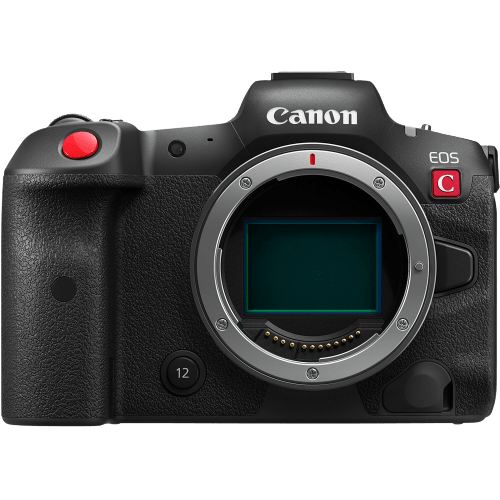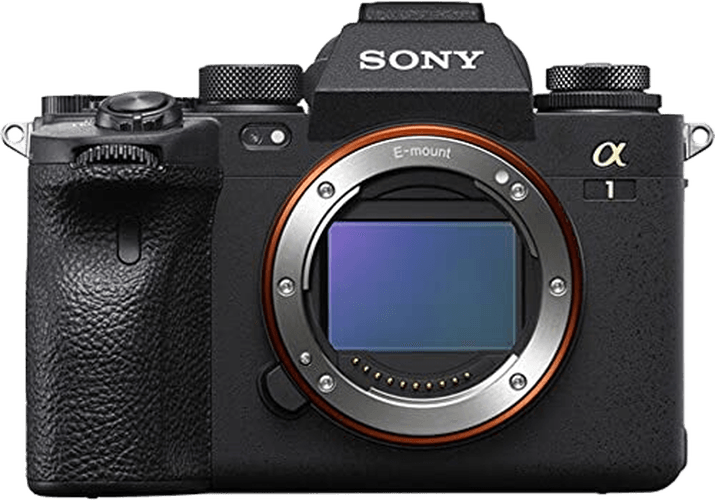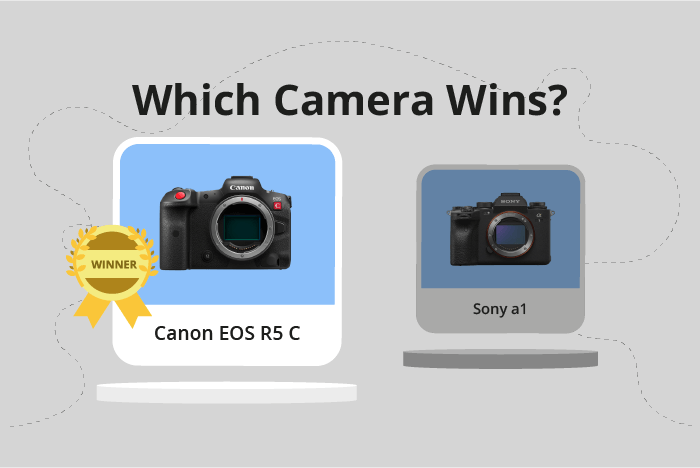Canon EOS R5 C vs Sony a1 Comparison
Canon EOS R5 C

Sony a1

The Canon EOS R5 C takes the lead with an 87/100 score, slightly edging out the Sony a1, which scored 86/100. Both cameras share similarities as mirrorless models, announced only a year apart – the R5 C in 2022 and the a1 in 2021.
The Canon EOS R5 C’s advantages include a lower launch price of $4499 compared to the Sony a1’s $6499, making it a more budget-friendly option. Additionally, the R5 C has a larger body, measuring 142 x 101 x 111mm, which might provide a more comfortable grip for some users.
On the other hand, the Sony a1 weighs less at 737g (1.62lbs) compared to the R5 C’s 770g (1.70lbs), potentially offering easier handling and portability. However, the difference in weight is minimal and might not affect user experience significantly.
Considering these points, the Canon EOS R5 C emerges as a more cost-effective option, while the Sony a1 offers a slightly lighter alternative. Both cameras deliver excellent performance and cater to different user preferences.
Canon EOS R5 C vs Sony a1 Overview and Optics
The Sony a1 edges out the Canon EOS R5 C in optics with a score of 89/100 compared to 88/100. Both cameras share several common specifications, including a CMOS sensor, full-frame sensor size, and image stabilization. They also have different lens mounts, with the Canon using the RF mount and the Sony employing the FE mount.
The winning camera, the Sony a1, boasts a higher megapixel count of 50.1, compared to the Canon’s 45 megapixels. This difference allows the Sony a1 to capture more detail and produce higher resolution images. Additionally, the Sony a1 has a faster shooting speed of 30 frames per second, compared to the Canon’s 20 frames per second. This makes the Sony a1 more suitable for capturing fast-moving subjects and action scenes. Furthermore, the Sony a1’s sensor has a DXOMARK score of 98, one point higher than the Canon’s 97, indicating a slight advantage in sensor performance.
On the other hand, the Canon EOS R5 C has its merits as well. Its Digic X processor is reliable and efficient, though it faces strong competition from the Sony a1’s Dual Bionz XR processor. The Canon RF lens mount offers a growing selection of high-quality lenses, but the Sony FE mount has a more extensive and established lens lineup.
In comparing the optics of these two cameras, the Sony a1 holds a slight advantage due to its higher megapixel count, faster shooting speed, and marginally better sensor performance. However, the Canon EOS R5 C remains a strong contender with its reliable processor and lens mount. Ultimately, the choice between these two cameras will depend on individual preferences and specific shooting requirements.
Canon EOS R5 C vs Sony a1 Video Performance
The Canon EOS R5 C outperforms the Sony a1 in video capabilities with a score of 100/100, a 14-point lead over the Sony a1’s score of 86/100. Both cameras share some common specifications, such as 8K max video resolution and 120fps max video frame rate. However, there are key differences that set the Canon EOS R5 C apart as the superior choice for video.
The Canon EOS R5 C boasts a higher max video dimension of 8192 x 4320, compared to the Sony a1’s 7680 x 4320. This difference allows the Canon EOS R5 C to capture more detailed and sharper footage, providing an advantage in professional video production settings. Additionally, the Canon EOS R5 C features built-in time-lapse functionality, which the Sony a1 lacks. This functionality makes it easier for users to create stunning time-lapse videos without the need for additional equipment or software.
The Sony a1 does not have any significant advantages over the Canon EOS R5 C in terms of video capabilities. Both cameras have the same max video frame rate and an 8K max video resolution, but the Canon EOS R5 C’s higher video dimensions and built-in time-lapse functionality give it a clear edge in this comparison.
Given these factors, the Canon EOS R5 C is the superior choice for video capabilities, with its higher max video dimensions and convenient built-in time-lapse functionality. The Sony a1, while still a strong contender, falls short in this aspect, making the Canon EOS R5 C the better option for videographers and content creators seeking top-notch video performance.
Canon EOS R5 C vs Sony a1 Features and Benefits
The Canon EOS R5 C wins the features comparison with a score of 87/100, while the Sony a1 scores 83/100. Both cameras share several specifications, including touchscreen capability, flip screens, WIFI, and Bluetooth connectivity. Neither camera offers GPS functionality.
The Canon EOS R5 C outperforms the Sony a1 in screen size and resolution. With a 3.2-inch screen and a resolution of 2,100,000 dots, the R5 C provides better image quality and a more comfortable viewing experience than the Sony a1’s 3-inch screen and 1,440,000-dot resolution.
Although the Sony a1 falls short in comparison to the Canon EOS R5 C, it still offers excellent features for photographers and videographers. The a1’s 83/100 score in features demonstrates its solid performance and capabilities. However, it is important to consider the specific needs of the user before choosing between these two cameras.
Taking into account the various features and specifications, the Canon EOS R5 C emerges as the better camera due to its larger screen size and higher screen resolution. The Sony a1, while still a strong contender, does not match up to the R5 C in these aspects. Ultimately, the choice between these cameras depends on the individual’s preferences and requirements, but the Canon EOS R5 C has a clear advantage in terms of features.
Canon EOS R5 C vs Sony a1 Storage and Battery
The Sony a1 edges out the Canon EOS R5 C in the storage and battery category with a score of 73/100 compared to Canon’s 68/100. Both cameras share common specifications, including two memory card slots, compatibility with SD cards, and USB charging capabilities.
The Sony a1 surpasses the Canon EOS R5 C in battery life, providing 530 shots per charge compared to Canon’s 320 shots. This longer battery life makes the Sony a1 more suitable for extended shooting sessions. Additionally, the Sony a1 uses the NP-FZ100 battery, which may offer better performance than Canon’s LP-E6NH battery.
Although the Canon EOS R5 C falls short in battery life, it accepts CFexpress B cards, which generally have faster write speeds than the Sony a1’s CFexpress Type A cards. This advantage may benefit photographers who require rapid data transfer for high-resolution images or video.
Considering these factors, the Sony a1 proves superior in battery life, while the Canon EOS R5 C offers a slight edge in storage capabilities. Ultimately, the choice between these cameras depends on the individual’s priorities regarding battery performance and storage speed.
Alternatives to the Canon EOS R5 C and Sony a1
Are you still undecided about which camera is right for you? Have a look at these popular comparisons that feature the Canon EOS R5 C or the Sony a1:

